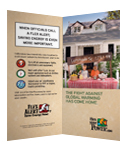Income-Based Energy Efficiency Programs
Income-qualified families are particularly susceptible to high and fluctuating energy costs, based on the earnings to expenditure ratio. Estimates indicate that while the average U.S. household's energy costs are equal to 7% of household income, income-qualified households spend 17% of their household earnings.
View current Low Income and Assistance Programs directly on the California Public Utilities Commission website.
Income-Based Energy Efficiency Program or Low Income Energy Efficiency (LIEE): Services include attic insulation, energy efficient refrigerators, energy-efficient cooling appliances, weather stripping, caulking, low-flow showerheads, water heater blankets, and door and building envelope repairs that reduce air infiltration.
Weatherization Program: Provides free weatherization services to improve the energy efficiency of homes, including attic insulation, weather stripping, minor housing repairs, and related energy conservation measures.
California Alternate Rates for Energy (CARE) Program: Provides a monthly discount on energy bills for income-qualified households.
Family Electric Rate Assistance (FERA ) Program: Provides a lower monthly rate for income-qualified households of three or more persons whose electric use reaches a certain level and who do not qualify for CARE.
Low Income Home Energy Assistance Program (LIHEAP): Provides financial assistance to eligible households to offset the costs of heating and/or cooling dwellings.
Energy Assistance Program Rate (EAPR): Includes a one-year electric rate reduction home energy audit, free compact fluorescent lights, and replacement of inefficient refrigerators. Income qualification and enrollment by Red Cross.
Energy Crisis Intervention Program (ECIP): Provides payments for weather-related or energy-related emergencies.
Medical Equipment Discount Rate: A medically based discount on water, gas, and/or electricity charges may be available for an applicant with a medical condition, treatment or equipment that causes higher than normal utilities consumption.
Lifeline Rate Program: Available to qualified income-qualified seniors (age 62 and over) and income-qualified disabled customers.
California Interfaith Energy Assistance Project (CIEAP): An energy assistance initiative for income-qualified people in seven designated geographic areas, serving nine counties in California.
Salvation Family Emergency Services: A program that addresses basic human needs, acting as a "safety net" for those who have nowhere else to turn. By providing food, clothing, utility assistance and counseling, caseworkers at Family Emergency Services prevent homelessness through crisis intervention.
Program Funding Sources
Efficiency funding for income-qualified families is key to our statewide drive towards increased energy efficiency.The short and long term benefits are economic relief and cost-effective home improvements. While assistance relieves pressure on individual households, the benefits also ripple into the community. With less money spent on energy, more money is available for other goods and services. If this money is spent locally, as is often the case, the local community captures this revenue, with further benefits rippling out from there.
Income-based energy efficiency funding comes from several sources.
A Public Goods Charge is part of every energy user's utility bill and used, in part, to fund income-qualified programs such as LIEE and CARE.
The U.S. Department of Energy (DOE) offers state and local funding earmarked specifically for home weatherization. This funding provides cost-effective energy-efficient light sources, showerheads, appliances, weatherization of windows and doors, tune-ups for heating and cooling units, and the installation of insulation.
Following the energy crisis of the 70s, in 1981 the U.S. federal government established the Low-Income Home Energy Assistance Program (LIHEAP). LIHEAP provides state, regional and local implementers a means to assist income-qualified energy customers in paying their bills. It also provides access to more efficient appliances.
Regional utilities have designed innovative volunteer programs that draw on their own clientele to assist other income-qualified clientele. This brings the educational aspect of energy efficiency into the purview of more Californians every day.










